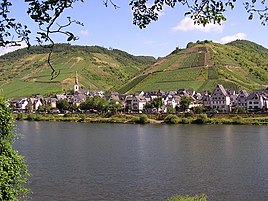Ediger
|
Ediger
Local community Ediger-Eller
Coordinates: 50 ° 5 ′ 52 ″ N , 7 ° 9 ′ 28 ″ E
|
|
|---|---|
| Height : | 148 m above sea level NHN |
| Residents : | 809 (Jun. 30, 2007) |
| Incorporation : | 7th June 1969 |
| Postal code : | 56814 |
| Area code : | 02675 |
|
View of the place
|
|
Ediger ( Moselle Franconian Edscha ) is a former town in Rhineland-Palatinate and is now part of the local community Ediger-Eller in the district of Cochem-Zell . The wine-growing area belongs to the Cochem association.
location
Ediger is located on the Lower Moselle , about six kilometers as the crow flies south of the district town of Cochem . Neighboring towns are Senhals and Nehren in the east, Neef on the other bank of the Moselle in the south and Eller (Moselle) in the west. Ediger is located on the federal highway 49 between Cochem and Wittlich and thus on the Moselweinstrasse . The Ediger Laach and Taubengrün Island are located southeast of Ediger .
history
The history of Ediger goes back to the year 636 after the first documentary mention in connection with a deed of donation from the Frankish king Dagobert I , pottery fragments found near the village suggest a settlement since the second or third century AD. 765 the place was named in connection with the donation of a wingert to the monastery Lorsch with the name Ederiga . In 895 several goods in the village came to the Echternach Abbey . Around 1097, a part of the church in the village of Edegrei in the Simeonstift in Trier belonged , the document attesting to this is the first mention of the church in Ediger.
In 1142 Ediger became the parish seat . In 1363 the site by emperors Charles IV. Of the Trier Archbishop at the request Cuno von Falkenstein , the city rights awarded. In the course of this, Ediger was surrounded with a city wall and ditches, received a blood court and market rights . From 1436 there was a jury in the town of Ediger . The existence of a school is mentioned for the first time in 1540. In the 17th century, most of the half-timbered buildings that still characterize the townscape were built.
In 1794 Ediger was occupied by French revolutionary troops and merged with the neighboring town of Eller to form a community. The Kurstaat Trier , to which the city belonged at that time, was dissolved. In 1815 Ediger and Eller were assigned to the Kingdom of Prussia at the Congress of Vienna , after which the two places became independent again. Ediger has belonged to Rhineland-Palatinate since 1946 , and on June 7, 1969, as part of the Rhineland-Palatinate regional reform, the town merged with the municipality of Eller (Mosel) to form the local municipality of Ediger-Eller .
On September 10, 2010, the twin town of Ediger-Eller was selected in the competition Our village has future as the most beautiful village in Rhineland-Palatinate and received one of eight gold medals in the federal decision. In 2014 Ediger took second place in the European Village Renewal Award .
Attractions
Monuments
The entire center of Ediger with many half-timbered buildings from the 16th, 17th and 18th centuries is, with the exception of two buildings, a listed building. Further cultural monuments are:
- Catholic parish church of St. Martin , a two-aisled, late Gothic parish church, probably from the 14th century. As early as 1097, a Romanesque predecessor building was mentioned, which was initially a branch church and was elevated to a parish church in 1142 . The redesign to the present church probably took place in the 14th or 15th century, the tower dates from 1506.
- city wall
- Kreuzkapelle above the vineyards north of Ediger
- former synagogue (Ediger)
- Hofgut Lehmen residential tower , Romanesque residential tower between Ediger and Nehren on the Moselle. The tower was first mentioned in 1245 and is the last remaining building on the estate of the von Lehmen family of knights . The tower is built from broken slate stones and is 16 meters high.
- The property of the Springiersbacher Hof , a winery founded in 1299 , is located directly below the parish church of St. Martin. The current building in Baroque style was rebuilt in 1752 and 1753 under Abbot Johann Heinrich von Wassenberg.
Half-timbered houses in Ediger
Economy and Infrastructure
The residents of Ediger live mainly from viticulture and tourism. The vineyards in the area include the Ediger Elzhofberg and the Ediger Osterlämmchen , where mainly Riesling is grown. The long-distance hiking trail " Moselsteig " leads through Ediger.
There is a primary school in Ediger.
Personalities
- Eduard David (1863-1930), politician (SPD), MdR , MdL (Hessen)
- Heinz Balthes (* 1937), stage designer
- Manfred Probst (* 1939), Catholic theologian
- Detlef Becker (1963–1982), banker, victim of a hostage-taking
Web links
Individual evidence
- ↑ Timeline for the Ediger district. Ediger-Eller parish, accessed on July 6, 2019.
- ↑ Official municipality directory 2006 ( Memento from December 22, 2017 in the Internet Archive ) (= State Statistical Office Rhineland-Palatinate [Hrsg.]: Statistical volumes . Volume 393 ). Bad Ems March 2006 (PDF; 2.6 MB). Info: An up-to-date directory ( 2016 ) is available, but in the section "Territorial changes - Territorial administrative reform" it does not give any population figures.
- ^ Gold medal for Ediger-Eller in the village competition. Rheinzeitung, September 10, 2010, accessed on July 6, 2019.
- ↑ Castle inventory - Lehmen residential tower. ( Memento of March 30, 2010 in the Internet Archive ) , accessed on July 6, 2019.








